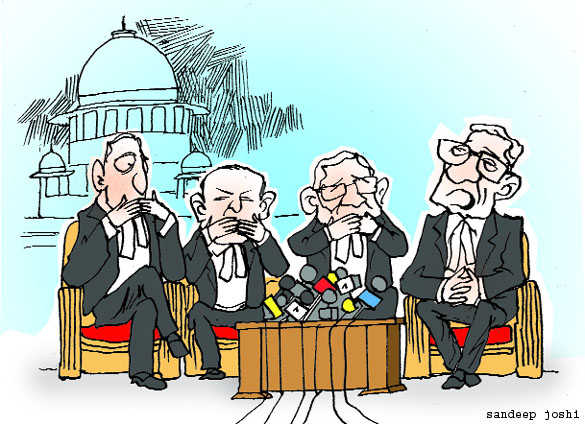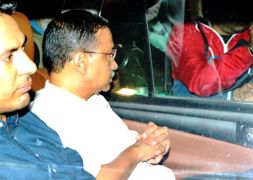
Harish Khare
ALL four of them looked so human, so vulnerable, so concerned and sincere, as well as so unfamiliar with the rough, chaotic rituals of a press conference; yet, the four seniormost judges did manage to produce an illuminatingly flagellant moment in Indian judiciary history, reminiscent of the day when Babu Jagjivan Ram and Hemvati Nandan Bahuguna walked out on Indira Gandhi in 1977. Indian politics changed that afternoon; the higher judiciary would not be the same after the extraordinary Friday the Twelfth.
The Supreme Court thrives on traditions, conventions, procedures and protocols; its operating principles and working habits have been anchored in anonymity, distance and detachment. It is these entrenched traditions and sanctified etiquette that enable even a lesser judicial mind to raise his game and to acquire for himself a patina of superior wisdom and judicial rectitude. Like any other institution, the Supreme Court too has evolved its own inhouse morals and mores. The four judges — Chelameswar, Gogoi, Lokur, and Joseph — must be presumed to have been immersed in this rigorous institutional culture. Yet, they went public most unprecedentedly with their dissatisfaction with Chief Justice Dipak Misra.
Why? Pray, indeed, why? Obviously these four seniormost judges must have had their overwhelming reason(s) to defy the ingrained protocol of silence and anonymity. Their grievance, first made privately to the Chief Justice, had remained unaddressed. The letter they have made public draws a portrait of a wayward Chief Justice, unbothered and unwilling to give the four senior brother judges the time of day. And, as the letter asserts, the foursome are not prepared to concede him any intellectual or judicial superiority. The only feasible conclusion is that there is an internal collapse within the highest judicial forum.
Any person who gets elevated as Chief Justice of India is called upon to show wise leadership if the institution over which he presides has to retain its vitality and robustness. And, if a Chief is not able to summon the requisite traits of prudence and wisdom to infuse Court No. 1, then he is expected to be sufficiently tactful in carrying with him the rest of the Bench, which may have on it more erudite and more forceful judicial minds than him. There is very little place for — to recall what Sardar Patel had to tell Harilal Kania three days before he became the first Chief Justice of India — “petty-mindedness” in how a “Chief” deals with his brother judges. It is incumbent upon a Chief Justice of India — indeed for anyone who presides over an institution — to corral fellow-judges into the joys and pleasures of judicial brotherhood and its internal code of mutual respect and consideration. The Chelameswar Four cannot be accused of not trying to keep open the lines of communication with the Chief, or, perhaps, wanting to save the Chief from himself.
Reading between the lines of the Chelameswar Four letter, it does appear that the whole shebang goes beyond the personal, intellectual or judicial inadequacies or strengths of the dramatis personae. The primary point of disagreement is about how to preserve "the integrity of the institution" (for judiciary). Since there is a pointed reference to the Memorandum of Procedure (for the appointment to the higher judiciary), it has to be presumed that the consuming divisiveness of our shabby politicians has contaminated the apex judicial body. The new India, with its insistence on introducing a new normal, was bound to make such a demand on the judiciary as an institution. Chief Justice Misra has been suspected of being less than zealous in wanting to preserve the judiciary’s institutional esteem and honour.
It can be easily conceded that from the very beginning in 1950 that the executive-judiciary balance has been determined to a very large extent by the nature of political dominance the ruling party of the day could command. It was only in the mid-1990s that the judiciary stonewalled itself sufficiently against the vagaries of the politician's world.
But like all institutions, the judiciary too is manned by individuals. And, we can no longer be under the illusion that judges are saints; or even sants. We do know that they do not live in ashrams or go on solo meditation retreats in distant monasteries. They are not untouched with current raging passions, furies and the certainties of the day. They all have closets at home. Many, if not all, also have feet of clay. And, though we pretend to not have a system of judges being "political appointees", some judges do have political alignments and leanings and patrons. Institutional pride and prestige compete with individual weaknesses and vulnerabilities. At the highest level of judiciary, the institution wins. So we like to presume.
We presume wrongly. That is the only inference possible from the indictment in the Chelameswar Four charge-sheet. The very pointed reference to the constitution of assorted Benches “of their preference” carries with it suggestion of less than honourable intent. More than individual failings, there is a foreboding of a bigger surrender in-the-making.
It is impossible to not take note of the elephant in the room — the Judge BH Loya case. And, that case is one that goes to the very core of the judiciary's role in ensuring that we remain a country governed by the rule of law. When a judge looking into an extremely sensitive case dies in mysterious circumstances, every single judicial functionary is left to draw his/her fearful conclusions. The entire judicial system collapses if a perception gets abroad that a powerful political personality can intimidate a judge or when judges start feeling vulnerable on account of their own physical safety.
It was — and remains — the duty of the Chief Justice of India to give confidence to the entire judicial fraternity that no magistrate across the land need feel unsafe under his watch. There may be a new India but there is no new Constitution of India. And, the citizens need to be reassured that they still have the protection of a judiciary, ferociously unyielding in its role as the custodian of rule of law. That assurance cannot come from a factionalist Chief Justice.



























